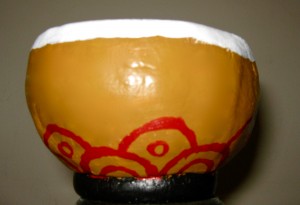Bàttu (Unity)
March 26th, 2012

I created this piece in response to The Beggars’ Strike, by Aminata Sow Fall. I sculpted a clay version of the calabash bowl carried by Senegalese beggars, and in decorating it, tried to convey the role that almsgiving plays in this society. In the novella, Sow Fall describes begging as an occupation no different from any other trade: in exchange for alms, the poor give their blessings, and help ease the consciences of donors.
Although a downtrodden population, the service they provide is depicted as integral to the functioning of society. Without the beggars to “drive away their bad dreams… and to maintain their hopes” (22) people are unable to unburden themselves of their troubles and fears. In this way, almsgiving is no longer an act of charity, but rather a safeguard against these worries.
The white interior of the bowl represents the purifying quality of almsgiving, and the hope that it imparts. The base of the bowl, in contrast, is black, as this is the part of the bowl closest to the beggar who is receiving this burden.

“O Prophet! Take alms of their wealth, wherewith you may purify them and may make them grow, and pray for them. Indeed, your prayers are reassurance for them.” (Qur’an 9:103)
Entry Filed under: Uncategorized